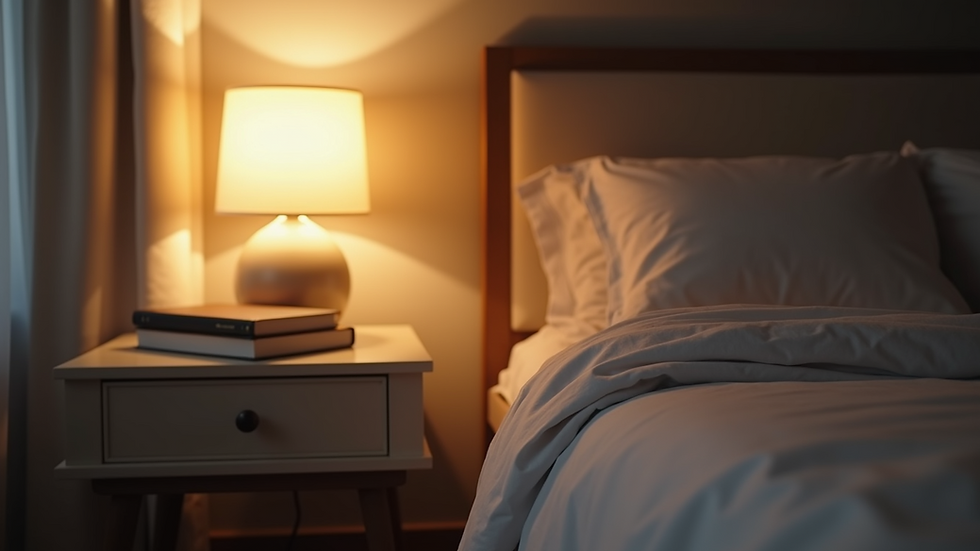Tips to Create a Relaxing Bedtime Routine
- Fern Atkinson
- Oct 27
- 4 min read
A calming bedtime routine is essential for winding down after a busy day. It helps signal to your body that it is time to rest, making it easier to fall asleep and stay asleep. Establishing a consistent routine can significantly improve your overall sleep quality and well-being. In this post, you will find practical tips and ideas to create a relaxing bedtime routine that suits your lifestyle.
Why a Consistent Bedtime Routine Matters
Having a regular bedtime routine helps your body and mind prepare for sleep. When you follow the same steps every night, your brain starts to associate these activities with rest. This association makes it easier to transition from wakefulness to sleep.
A consistent routine can also reduce stress and anxiety. When your mind knows what to expect, it is less likely to race with worries or distractions. This calm state is crucial for falling asleep quickly and enjoying deep, restorative sleep.
Some benefits of a bedtime routine include:
Improved sleep onset and duration
Reduced nighttime awakenings
Enhanced mood and energy the next day
Better management of stress and anxiety
By dedicating time to unwind, you create a peaceful environment that supports your body’s natural sleep cycle.

How to Build Your Ideal Bedtime Routine
Creating a bedtime routine that works for you involves choosing activities that promote relaxation and avoiding those that stimulate your mind or body. Here are some steps to help you build an effective routine:
1. Set a Consistent Bedtime
Choose a time to go to bed each night and stick to it, even on weekends. This consistency helps regulate your internal clock, making it easier to fall asleep and wake up naturally.
2. Dim the Lights
Lowering the light in your environment signals your brain to produce melatonin, the hormone that controls sleep. Use soft, warm lighting or candles about an hour before bed.
3. Limit Screen Time
Avoid screens such as phones, tablets, and TVs at least 30 minutes before bedtime. The blue light emitted by these devices can interfere with melatonin production and disrupt your sleep cycle.
4. Engage in Relaxing Activities
Choose calming activities that help you unwind. Some examples include:
Reading a book
Listening to soothing music or nature sounds
Practicing gentle yoga or stretching
Taking a warm bath or shower
5. Create a Comfortable Sleep Environment
Make sure your bedroom is cool, quiet, and dark. Invest in comfortable bedding and pillows that support your preferred sleeping position.
6. Avoid Heavy Meals and Caffeine
Try not to eat large meals or consume caffeine within a few hours of bedtime. These can cause discomfort or keep you alert when you want to sleep.
By following these steps, you can design a bedtime routine that prepares your body and mind for restful sleep.

What is the 123 Sleep Rule?
The 123 sleep rule is a simple guideline to help you fall asleep faster and improve the quality of your rest. It involves three key steps:
One deep breath - Take a slow, deep breath to calm your nervous system.
Two positive thoughts - Think of two things you are grateful for or that made you happy during the day.
Three muscle relaxations - Starting from your feet, consciously relax three muscle groups, moving upward toward your head.
This technique helps reduce stress and anxiety by focusing your mind on positive and calming sensations. It also encourages physical relaxation, which is essential for falling asleep quickly.
Try incorporating the 123 sleep rule into your bedtime routine to enhance your ability to drift off peacefully.
Additional Tips to Improve Sleep Quality
To further enhance your sleep, consider these additional tips:
Limit naps: If you nap during the day, keep it short (20-30 minutes) and avoid late afternoon naps.
Exercise regularly: Physical activity during the day can help you fall asleep faster, but avoid vigorous exercise close to bedtime.
Manage stress: Practice mindfulness, meditation, or journaling to reduce stress levels before bed.
Avoid alcohol before bed: While alcohol may make you feel sleepy initially, it can disrupt your sleep cycle later in the night.
If you want to learn more about how to improve sleep quality, there are many resources and products designed to support better sleep habits.
Making Your Bedtime Routine a Habit
Consistency is key when it comes to bedtime routines. Here are some strategies to help you stick with your new routine:
Start small: Begin with one or two relaxing activities and gradually add more as you feel comfortable.
Set reminders: Use alarms or notes to remind yourself when it’s time to start winding down.
Be patient: It can take several weeks for your body to adjust to a new routine, so give yourself time.
Track your progress: Keep a sleep journal to note how you feel each morning and identify what works best.
By making your bedtime routine a regular part of your day, you will create a positive habit that supports restful sleep and overall health.
Creating a relaxing bedtime routine is a powerful way to improve your sleep and overall well-being. By setting a consistent schedule, engaging in calming activities, and making your sleep environment comfortable, you can enjoy more restful nights and energized days. Start small, be patient, and watch how your sleep transforms for the better.

.png)


